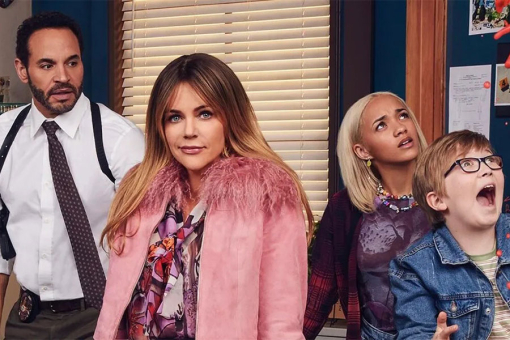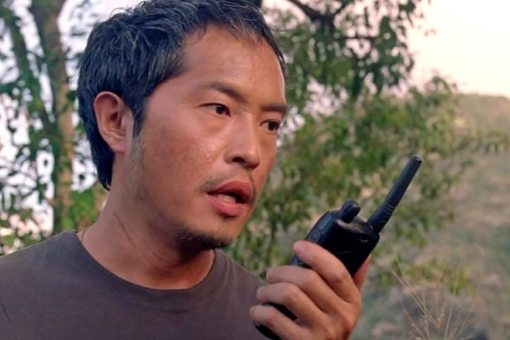Two high-profile primetime series premiered on ABC in early 1990. The first one, America’s Funniest Home Videos, continues to air on Sunday nights. The other one was promptly cancelled in June 1991 due to low ratings.
Now let’s roll the tape: David Lynch never took a baseball bat to the groin, and his wonderfully bizarre drama/soap opera/whodunnit known as Twin Peaks remains influential and iconic TV.
Though hot off his 1986 film Blue Velvet at the time, the avant-garde writer-director was intrigued by the serial format and eager to try it. He teamed with former Hill Street Blues writer Mark Frost, and they went to work on crafting a murder-mystery set in a fictional town in the Pacific Northwest. The two presented their idea to ABC executives in 1989, and a two-hour pilot was promptly ordered. “They would have been concerned with my image had I come in on my own,” Lynch told Entertainment Weekly in 1990. “But Mark took the edge off.”
Still, upon its premiere on April 8, 1990, it was obvious this was a David Lynch production. Start with the dapper detective Dale Cooper (Blue Velvet’s Kyle MacLachlan) — sent to Twin Peaks to investigate the death of homecoming queen Laura Palmer (Sheryl Lee) — who quickly becomes surrounded by a coterie of memorable characters. There was also absurd humor, close-up camera angles to ratchet up the tension and eerie synth music from Angelo Badalamenti. The most Lynchian tell of all: Beneath the town’s cozy surface was a dark underbelly of incest, rape and abuse. Honestly, it feels like a minor miracle the show ever made it to air.

Those first two episodes, broadcast together as the pilot, attracted 36 million viewers. Critics called it groundbreaking TV. The first season was nominated for 14 Emmy awards.
But after Laura’s killer was revealed in season two and the show got bumped to Saturday nights, ratings dropped off and Twin Peaks met its demise. Nonetheless, just like the coffee at the Double R Diner, Lynch caused a stir in 2017 when he delivered the well-received Twin Peaks: The Return on Showtime.
Thirty-five years after its debut, Twin Peaks’ DNA can still be found on basically every buzzy offering since the ‘90s. Here are five ways the show changed TV.
1. It Ushered in the Central Mystery Narrative
Who killed Laura Palmer? The question is posed at the very start of the very first episode when Pete Martell (Eraserhead’s Jack Nance) discovers Laura Palmer’s lifeless body wrapped in plastic on the beach. It also drove the storyline for Twin Peaks’ entire first season, as many characters emerged as suspects. (By comparison, Dallas was two years into its run when J.R. Ewing was shot, and Jessica Fletcher solved every mystery by the closing credits of Murder, She Wrote.) The sprawling whodunnit has since factored into everything from True Detective to Desperate Housewives to Only Murders in the Building. Meanwhile, series like Paradise have offed their protagonist à la poor Laura before the action gets going.
2. It Established Its Own Time and Place
Here’s how The Washington Post TV critic Tom Shales praised Twin Peaks in 1990: “Twin Peaks isn’t just a visit to another town; it’s a visit to another planet. Maybe it will go down in history as a brief and brave experiment. But as can be said of few other TV shows in the near or immediate future: This You Gotta See.”
Indeed, though Twin Peaks was set in the present day, Lynch and Frost transported viewers into a surreal 1950s-like universe that included doughnuts, cherry pie and saddle shoes worn by femme fatale Audrey Horne (Sherilynn Fenn). And in this strange fog-shrouded dimension, mind-bending stuff keeps happening for reasons that often go unexplained. (Hello, The Red Room.) Does that sound like Lost or Severance to you? It should.
3. It Fostered Crazy Fandom

Fans didn’t watch Twin Peaks like they watched Night Court or Matlock. With its crazy twists and oddball clues — gah, the “R” that Agent Cooper tweezes out from beneath the corpse’s fingernail! — they obsessed over every out-there moment back when “Easter eggs” were just a holiday reference and “going viral” meant grabbing the tissues. The internet itself barely existed in 1990, so instead of live-tweeting or taking to Reddit, viewers held watch parties in bars and talked around the literal office water cooler.
They also purchased merchandise, like the NSFW novel The Secret Diary of Laura Palmer. When the show was cancelled, they wrote snail-mail letters to protest! Now, of course, it’s all too easy to turn a riveting what-just-happened episode of The White Lotus or Yellowjackets into a communal experience.
4. It Introduced the Concept of Eccentric Ensemble Characters
The Log Lady. Big Ed. The Man from Another Place. The Giant. The Waiter. Nope, we’re not in Mayberry anymore. These small-town folks looked and behaved differently from the ones who came before them, and sometimes they weren’t actually folks at all. Consider: The One-Armed Man (Al Strobel) was a demonic spirit, while his former partner, BOB (Frank Silva), was a terrifying force who may or may not have been responsible for Laura’s death. Even MacLachlan’s throwback Agent Cooper didn’t fit the mold of the all-knowing, square-jawed TV detective.
A few years later, The X-Files cultivated its own unusual suspects. And by the end of the decade, The Sopranos presented a cast that didn’t fit the mold, boasting sinister characters to spare.
5. It Proved that Film Auteurs Can Do TV

Lynch — who died January 16, 2025, at age 78 — wasn’t the first established film director to do TV. But coming off the cult favorites of Eraserhead, The Elephant Man, Dune and Blue Velvet (with Wild at Heart premiering at the 1990 Cannes Film Festival), Lynch’s entree into the medium seemed like an unnecessary gamble. His success remains a crucial part of TV history, because he pulled off his uncompromising artistic vision despite network standards and practices — not to mention all those commercial breaks. (To that end, each segment played like a climactic mini-movie.)
Before Twin Peaks: The Return, Lynch (with Frost) worked on two other series, On the Air and American Chronicles. Both were cancelled after three episodes.
Now filmmakers toggling back and forth between TV and features is de rigueur, as the likes of David Fincher (Mindhunter), Rian Johnson (Poker Face), Jordan Peele (The Twilight Zone) and Tim Burton (Wednesday) have all followed suit.











